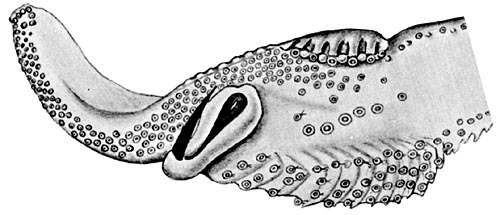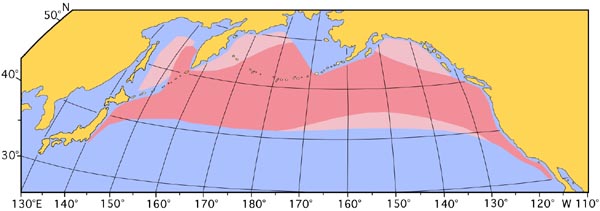Gonatus onyx
Tsunemi Kubodera, F. G. Hochberg, and Richard E. YoungIntroduction
Gonatus onyx is a small and common species of Gonatus. Spent females reach a size of 132-145 mm ML (Seibel, et al., 2000).Diagnosis
A Gonatus with ...
- a single hook on the tentacular club.
- usually less then 10 suckers in the medial zone of the tentacular stalk.
Characteristics
- Arms
- Total of 25-30 hooks and suckers present on proximal half of each arm I-III; squid >40 mm GL with 30-37 suckers on proximal half of each arm IV.
- Total of 25-30 hooks and suckers present on proximal half of each arm I-III; squid >40 mm GL with 30-37 suckers on proximal half of each arm IV.
- Tentacles
- Clubs 20-25% of GL.
- Club dactylus with 5-6 irregular series at proximal end but quickly decreasing to 4 series; over most of dactylus suckers in transverse series approximately equal in size.
- Club ventral-marginal zone with 4 (rarely 5) series of suckers in central part; suckers of medial suckers ca. one-half diameter of suckers of marginal series.
- Club dorsal-marginal zone with 2-3 irregular series dorsal to large central hook.
- Club medial zone with large central hook and proximal series of suckers; proximal suckers never transformed into hooks. Usually no zone member distal to central hook, occasionally large sucker present that may bear a large tooth; rarely a small hook present but usually on just tentacle.
- Total number of suckers (excluding terminal pad and medial zone) on tentacular club: about 160-200.
- Median region of tentacular stalk between marginal series with ca. 0-27 suckers (usually less than 10) scattered suckers.
 Click on an image to view larger version & data in a new window
Click on an image to view larger version & data in a new window


Figure. Oral view of the tentacle of G. onyx, 69 mm GL. Top - Distal region of tentacle. Middle - Enlargement of club from top figure. Drawings from Young (1972). Bottom - Right tentacular club, paratype, 98 mm ML, female. Photograph by R. Young.
- Head
- Beaks: Descriptions can be found here: Lower beak; upper beak. See this site also.
- Photophores
- Photophores absent
Comments
Life History
Gonatus onyx females brood their young in deep water. Five females have been observed with an ROV carrying large egg masses at depths of 1539 -2522 m in Monterey canyon off California (eastern North Pacific). The black egg mass, with 2000-3000 eggs, is a hollow tube open near the mouth and at the distal end. The gelatinous tube walls consist of double membranes that join together forming a single-layer honeycomb with a single egg in each chamber of the honeycomb. Regular movements of the arms (every 30-40 sec) flush water through the egg mass to aerate the embryos. The black color of the egg mass probably comes from ink released by the female (Seibel et al. 2000; Seibel, et al. 2005).
A video of one of the brooding squid observed by Seibel, et al. 2005, can be seen here. The video starts slowly but is impressive near the end. The embryos were ready to hatch and, peerhaps, the disturbance created by the ROV stimulated hatching.
Water temperatures where the females were observed varied between 1.7 - 3.0°C and at these temperatures the embryos may require as long as 6-9 months to develop. Brooding females lack tentacles, hold onto the egg mass with arm hooks,and apparently don't feed during brooding. High lipid content of the digestive gland and protein in the mantle muscle of the female presumably fuel the metabolism through this long brooding period. Observations of declines in these fuels and female activity with increasing stage of embryonic development support this assumption(Seibel et al. 2000; Seibel, et al. 2005).
Observation of a brooding gonatid in shallow water in the Sea of Okhotsk (Okutani, 1995) combined with the distance required for hatchlings to reach their surface habitat from the brooding sites off California suggests that females transport the egg masses to near-surface waters at the time of hatching (Seibel et al. 2000).



Figure. Left - Ventrolateral view of G. onyx brooding a mass of eggs at a depth of 1539 m in Monterey Canyon off California. ROV photograph from Seibel et al. (2005), © 2002 MBARI. Right top - Frontal and cross-sectional views of pieces of an egg mass of G. onyx. Right bottom - Side view of a hatchling from the egg mass. The club has 70-90 sucker buds. Drawings from Seibel, et al. (2000).


Figure. Laboratory hatchling of G. onyx from a captured egg mass, ca. 3 mm ML. Photograph from Seibel, et al. (2005).
Paralarvae collected in the plankton can be identified by the dorsal-head chromatophore pattern which is Type II-1 [three transverse rows of chromatophores with one chromatophore in the anterior row (this is missing, hence the "-1" attached to "Type II"), two in the middle row and three in the posterior row]; the mantle has one dorsal and four lateral chromatophores (Jorgensen, 2006).


Figure. Dorsal views of the chromatophores of a G. onyx paralarva, 8.9 mm ML, Gulf of Alaska. Left - Head. Right - Paralarva. Drawing from Jorgensen (2007).
We have seen two young G. onyx, 38 and 31 mm ML, with mantle chromatophores intact, that show several, large chromatophores on each side of the mantle (see photograph below). These chromatophores were even more pronounced in the preserved specimens and may prove to have systematic value. At 31 mm ML the squid had virtually no chromatophores on its ventral surface of the mantle but abundant mantle chromatophores elsewhere.


Figure. Dorsolateral view of a barely alive G. onyx, 38 mm ML, off Monterey, California, showing the large, lateral, mantle chromatophores (arrows). Also note the orange digestive gland that is small and well posterior to the head. © Danté Fenolio
The size of the juvenile at which the various hooks first develop is often distinctive of the species.
Behavior

Figure. Dorsal view of G. onyx in the Dorsal Arm-curl posture at a depth of 950 m. Photograph© 2013 MBARI.
Distribution
Type locality: 33°19'N, 118°45'W, eastern North Pacific off Southern California. G. onyx is broadly distributed across the North Pacific.
References
Jorgensen, E. M. 2007. Identification, distribution and relative abundance of paralarval gonatid squids (Cephalopoda: Oegopsida: Gonatidae)from the Gulf of Alaska, 2001-2003. Journ. Molluscan Studies, 73: 155-165.
Okutani, T., T. Kubodera and K. Jefferts. 1983. Diversity, distribution and ecology of gonatid squids in the subarctic Pacific: A review. Bull. Ocean Res. Inst., Univ. Tokyo, No. 26 (1):150-192.
Okutani, T., I. Nakamura and K. Seti. 1995. An unusual egg-brooding behavior of an oceanic squid in the Okhotsk Sea. Venus 54: 237-239.
Seibel, B. A., F. G. Hochberg, and D. B. Carlini. 2000. Life history of Gonatus onyx (Cephalopoda: Teuthoidea): deep-sea spawning and post-spawning egg care. Marine Biology 137 (3): 519-526.
Seibel, B. A., B. H. Robison and S. H. D. Haddock. 2005. Post-spawning egg care by a squid. Nature 438: 929.
Young, R. E. 1972. The systematics and areal distribution of pelagic cephalopods from the seas off Southern California. Smithson. Contr. Zool., 97: 1-159.
Information on the Internet
- Baby Squid, Born Like Stars. Video of a brooding Gonatus squid. Wholphin DVD magazine.
Title Illustrations

| Scientific Name | Gonatus onyx |
|---|---|
| Location | Eastern North Pacific off Monterey, California at 36.8°N, 122 1°W |
| Comments | In situ photograph of Gonatus onyx taken at a depth of 784 m. |
| Acknowledgements | Image courtesy of the Monterey Bay Aquarium Research Institute (MBARI). You must obtain permission from MBARI to use this photo; please contact pressroom@mbari.org for further information. |
| Specimen Condition | Live Specimen |
| Identified By | Stephanie Bush |
| View | Dorsolateral |
| Size | Unknown |
| Copyright | © 2013 MBARI |
About This Page

National Science Museum, Tokyo, Japan
F. G. Hochberg

Santa Barbara Museum of Natural History, Santa Barbara, California, USA

University of Hawaii, Honolulu, HI, USA
Page copyright © 2016 , F. G. Hochberg, and
 Page: Tree of Life
Gonatus onyx .
Authored by
Tsunemi Kubodera, F. G. Hochberg, and Richard E. Young.
The TEXT of this page is licensed under the
Creative Commons Attribution-NonCommercial License - Version 3.0. Note that images and other media
featured on this page are each governed by their own license, and they may or may not be available
for reuse. Click on an image or a media link to access the media data window, which provides the
relevant licensing information. For the general terms and conditions of ToL material reuse and
redistribution, please see the Tree of Life Copyright
Policies.
Page: Tree of Life
Gonatus onyx .
Authored by
Tsunemi Kubodera, F. G. Hochberg, and Richard E. Young.
The TEXT of this page is licensed under the
Creative Commons Attribution-NonCommercial License - Version 3.0. Note that images and other media
featured on this page are each governed by their own license, and they may or may not be available
for reuse. Click on an image or a media link to access the media data window, which provides the
relevant licensing information. For the general terms and conditions of ToL material reuse and
redistribution, please see the Tree of Life Copyright
Policies.
- First online 31 May 2006
- Content changed 11 October 2015
Citing this page:
Kubodera, Tsunemi, F. G. Hochberg, and Richard E. Young. 2015. Gonatus onyx . Version 11 October 2015. http://tolweb.org/Gonatus_onyx/19769/2015.10.11 in The Tree of Life Web Project, http://tolweb.org/












 Go to quick links
Go to quick search
Go to navigation for this section of the ToL site
Go to detailed links for the ToL site
Go to quick links
Go to quick search
Go to navigation for this section of the ToL site
Go to detailed links for the ToL site